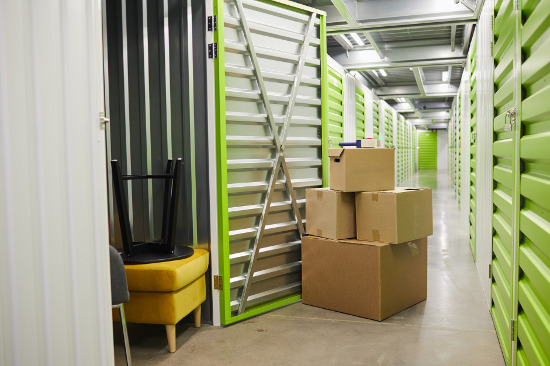Renting a storage unit can be an excellent solution for decluttering, organizing, and securing your belongings. Whether you’re downsizing, moving, or simply need extra space, utilizing a storage unit effectively can make a significant difference. Read below for all of the tips you need to help keep your items safe while they’re being stored.


Choose the Right Size
Carefully assess the number of items you plan to store. Opt for a self storage unit that offers enough space to accommodate your belongings while leaving some room for easy access and movement.
Climate Control
Consider a climate-controlled unit if you’re storing temperature- or humidity-sensitive items such as antiques, electronics, or wooden furniture. This feature helps maintain stable conditions and protects your valuables from damage.
Create an Inventory
Make a detailed inventory of everything you plan to store. This will help you keep track of your items and locate them quickly when needed. It can also help with making sure everything is removed from the unit and that nothing is missing.
Labeling
Label every box and container with a description of its contents. This will save you time and effort when retrieving specific items. It will also help when moving to make sure the boxes go to the right room after the move. Use permanent markers or a label maker to create the labels to prevent fading and other issues.
Utilize Shelving and Pallets
Maximize vertical space by using shelving units and pallets. They help keep your belongings off the floor and protect them from potential damage. It can also help give you more space to fit everything.
Secure Your Belongings
Invest in sturdy padlocks and security seals to protect your storage unit. Additionally, consider using a heavy-duty chain or cable to secure larger items together. When choosing boxes, opt for more durable options and stack them carefully to prevent falling boxes in the unit.
Use Protective Covers
Cover furniture, mattresses, and other vulnerable items with protective covers to shield them from dust, dirt, and potential scratches. Protection can help the items last a lot longer, so they’re still perfect when they’re stored in the best storage container.
Disassemble Furniture
Whenever possible, disassemble large furniture items to save space and protect them during transport and storage. Disassembled furniture will often fit in boxes, allowing for further protection during storage. Plus, it’s easier to move items when they’re smaller, so it may be possible for a single person to move the furniture when it’s in pieces.
Protect Fragile Items
Wrap fragile items, such as glassware and China, in bubble wrap or packing paper individually. Store them in sturdy boxes, clearly labeled as fragile. Stack these boxes near the top of the unit to avoid putting anything heavy on them.
Pack Strategically
Pack heavier items in smaller boxes to avoid them becoming too heavy to lift. Place lighter items in larger boxes. Fill gaps with packing materials to prevent items from shifting.
Store Valuables Securely
If possible, avoid putting anything extremely valuable in the storage unit. However, if anything valuable does need to be stored, even for a short time, make sure it’s done right. Keep valuable items such as jewelry, important documents, and cash in a locked box within your storage unit. This adds an extra layer of security just in case anyone enters the storage unit.
Preserve Wood Items
Wood will dry out over time and can warp or crack, especially if the furniture is on its side, taken apart, and in a unit that’s not climate controlled. Apply a coat of wood polish or protective oil to wooden furniture before storing. This helps prevent drying, cracking, and warping and can be a good way to ensure the wood furniture remains in good shape.
Create an Accessible Layout
Arrange your storage unit with a well-thought-out layout. Leave pathways to easily access all areas of the unit without moving or damaging other items. Place frequently accessed items near the front of the unit for easy retrieval. Keep a clear aisle in the middle to allow movement and access to the back of the unit.
Use Uniform Boxes
Using boxes of the same size and shape makes stacking and organizing more efficient, maximizing the use of space within your unit. Moving kits or packages are often available, making it easier to get a collection of boxes that all match.
Keep Items off the Floor
To prevent potential damage from moisture or pests, avoid storing items directly on the floor. Utilize pallets or raised shelves to keep them elevated. If there is an emergency, like flooding, the items will still be safe.
Don’t Store Perishable Items
Avoid storing any perishable items or food in your storage unit. This can attract pests and lead to unpleasant odors and damage. Other items in the unit can be easily damaged by pests, which could mean losing something important while it’s in storage.
Protect Against Dust
Seal boxes with packing tape to keep dust out. You can also use plastic wrap or furniture covers to further protect items from dust accumulation. Dust will appear quickly, so even if the storage unit is only used for a few months, protecting against dust is important.
Regularly Maintain Your Unit
Visit your storage unit periodically to check for any signs of moisture, pests, or damage. Promptly address any issues to ensure the safety and integrity of your belongings. Addressing issues can include pest control, repacking boxes, or pulling something out of the storage unit to keep it safe from further damage.
Insurance
Consider obtaining insurance coverage for your stored items. Check with your insurance provider to see if your homeowner’s or renter’s insurance covers storage units, or explore separate storage insurance options.
By implementing these tips, you can make the most of your storage unit, ensuring the safety, organization, and accessibility of your belongings. Remember, careful planning and strategic packing will go a long way in maximizing your storage space and preserving your items for the future.
























